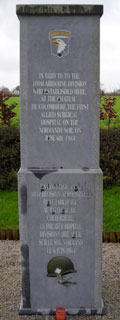Hiesville
Hiesville: General Pratt's Memorial


General Pratt of the 101st Airborne was initially supposed to land with elements of the 101st Airborne and arrives on Utah Beach during the afternoon of D-Day.
Prior to General Pratt's jump, however, General Maxwell D. Taylor persuaded Pratt to join the first wave of gliders to land in Normandy, instead.
La Colombière:

First American surgical hospital.

Monument at Château de Colombière.
Pratt would have preferred to jump with his men, but he had not completed the necessary training to qualify him to make a parachute jump at the time.
Unknown to Pratt, his glider was seriously overloaded, and it crashed in a field at the site of this memorial.
He was the first United States General to be killed in action during the Invasion.
From left to the right:
- 1st Lt Lee J. MAY, co-pilot,
- Brig. Gen. Donald F. PRATT, Assistant Division Commander of Gen. Maxwell TAYLOR Commanding the 101st Airborne,
- Lt Col. «Mike» MURPHY, pilot,
- Lt John M. BUTLER, aide de camp, facing The Fighting Falcon in England on June 5th 1944.
General Maxwell Taylor HQ at Hiesville
Le Cauday's farmhouse is north of Vierville-au-Plain and outside the hamlet of Hiesville, that was the first Headquarters of General Maxwell Taylor, Commander of the 101st Airborne. General Taylor kept his Headquarters at this location for 8 days following June 6th, 1944. If you look carefully in between the two chimneys is an antenna that was placed there by an Airborne Pathfinder who jumped into Normandy a couple of hours before the majority of the troops from the 101st and 82nd came in. The job of the Pathfinders was to set up radio and light beacons to guide the C-47s to their drop zones.

There are two good stories about the Pathfinder who landed here. One has him landing on the roof, which probably isn't the case. The other has him landing right near the house, and the landing and dropping his chute, etc., caused a bit of noise and a little boy who lived in the house came out to see what caused the commotion. The trooper didn't speak French, but he put his finger to his mouth and went «chuuuut». The boy led him into the house where he went up on the roof and put up his beacon.
Exhausted, the trooper collapsed in an empty bed in the house. He woke up to a violent kicking of the bed in the morning and looked and saw an American officer there who told him to get out of the house. It turns out that they commandeered the place for General Taylor, the commander of the 101st and they didn't want some trooper in his bed.
The family there at the time left up the antenna and placed that memorial Airborne plaque on their gatepost. When leaving this stop you can visit the sight of the First Allied Surgical Hospital at Château de Colombière.